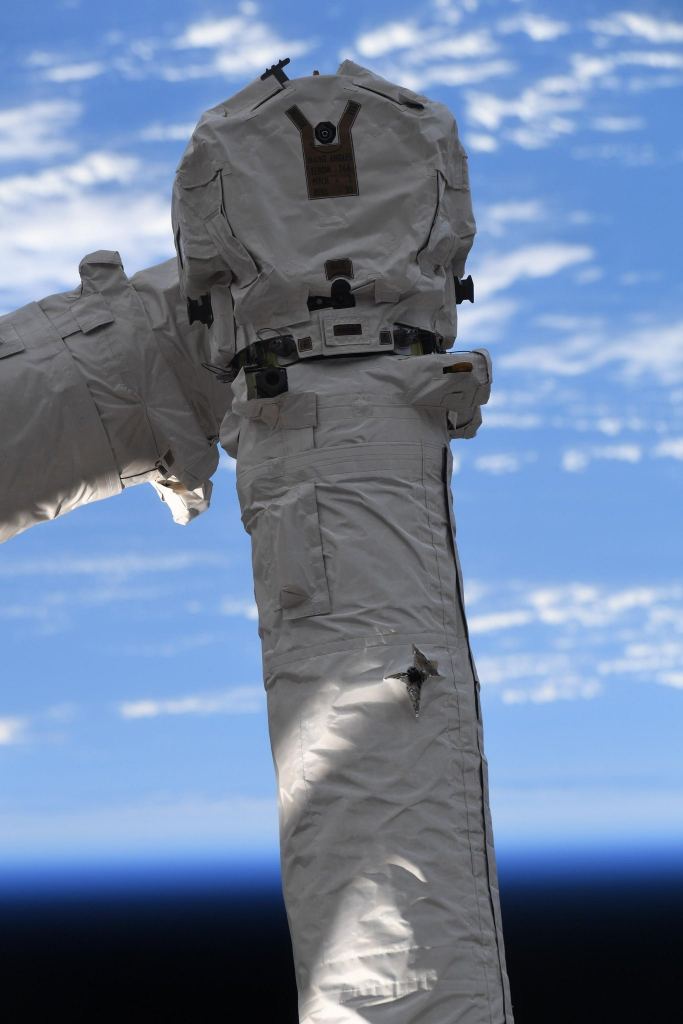
Ouch. Canadarm2 Took a Direct Hit From a Micrometeorite
Living in space comes with risks. For astronauts on the International Space Station (ISS), those risks occasionally make themselves intrusively apparent.
Earlier this month, European Space Agency astronaut Andreas Mogensen snapped a photo of the Canadarm2, in which forfeiture from a micrometeorite impact is unmistakably visible.
“The slum was made in 2021, where a 1 mm object, traveling at over 25,000 km/h relative to the Space Station hit the robotic arm. Fortunately, no hair-trigger components were damaged,” said Mogensen on social media.
The impact punched through the arm’s thermal wrap and impacted the boom. The robotic arm, which has been in service on the ISS for over twenty years, continues to function normally.
But the ISS isn’t unchangingly so lucky. In October, the Nauka science module suffered forfeiture from a similar micrometeorite impact, causing 72 litres of coolant to leak from the module’s radiator out into space. After determining that the leaking coolant might contaminate astronauts’ spacesuits, a spacewalk planned for October 12th was postponed. Mogensen, slantingly NASA astronaut Loral O’Hara, was scheduled to recover science samples from the station exterior, where tests are ongoing to measure the worthiness of resilient microbial life to survive in space. In addition, the pair were expected to siphon out a variety of exterior maintenance activities, including camera replacements and jumper subscription installations.
That spacewalk will now occur in January or February 2024.

In its decades-long history, the ISS has so far avoided any serious forfeiture to its pressurized modules. The station has the worthiness to maneuver itself out of harm’s way in the specimen of a tropical tideway with a known piece of space debris. These evasive deportment have occurred regularly throughout the ISS’s operations, occurring at a undulation of once or twice per year (and thrice in increasingly recent years).
The rencontre is knowing when trash might be on a standoff course.
Ground-based orbital trash tracking programs currently monitor well-nigh 33,000 pieces of known space debris. But smaller pieces of trash and micrometeorites cannot be tracked from Earth, so the station relies on shielding to protect itself. A multi-layered structure known as Whipple shielding disperses the gravity of impact over a wider area, preventing depressurization.
There are moreover technology sit-in tests in the works for on-orbit trash trackers, which will be worldly-wise to snift much smaller pieces of trash (as small as 3 cm).
In the meantime, astronauts like Mogensen stay ready for the worst-case scenario. A thoughtfully planned regimen of emergency procedures is one way that space agencies try to minimize the risks.
“Most of the modules have shielding versus smaller impacts, but it is not strong unbearable to withstand impacts versus larger ones,” says Mogensen. “This is why we repeatedly practice emergency scenarios, including depressurization.”
Mogensen will stay in orbit until February 2024, when he will return to Earth with four of his crewmates on a SpaceX Dragon capsule. This is Mogensen’s second mission in space.
“Pierced Canadarm2,” ESA.
 The Defence Blog
The Defence Blog